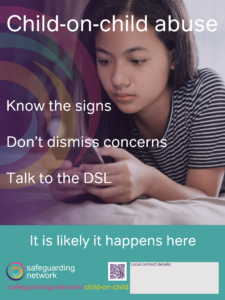Introduction
Everyone should be aware that children can abuse other children. Child-on-child abuse can happen both inside and outside of a setting, face-to-face and online. Organisations working with children play an important role in preventing and responding to child-on-child abuse.
An Observer investigation revealed a sharp increase in reports of abuse by under-18s to the police, including an 81% rise in reports of incidents on school premises.
Data from police forces in England and Wales between 2019 and 2022 suggested:
- A 40% increase in reports of sexual assaults and rapes where both the alleged victim and perpetrator were under 18.
- A 33% increase in rape reports and a 26% increase in reports where the allegation was against a child aged under 10.
- More than 2,700 recorded incidents took place on school property in 2022.
As with any form of abuse, child-on-child abuse can result in significant, long-lasting trauma, isolation, physical harm, poor mental health, a child missing education, and poor outcomes.
Need more?
Thank you for visiting our resources pages. These are free to everyone as is our fortnightly safeguarding bulletin – general safeguarding information is too important to restrict. Become a member to access lots more, including training materials for you to deliver in-house on each topic in Keeping Children Safe in Education.
Sign up for FREE fortnightly bulletin.
What about training?
We can deliver training for your setting on this and other subjects via online platforms, or face-to-face in certain areas. Just get in touch to discuss your requirements.
Definition of child-on-child abuse
Inappropriate behaviours between children that are abusive in nature including physical, sexual, or emotional abuse, exploitation, sexual harassment, all forms of bullying, coercive control, hazing/initiation rituals between children and young people, both on and offline (including that which is within intimate personal relationships).
Adapted from Keeping Children Safe in Education
We should remember that child-on-child abuse is harmful to both the perpetrator and the victim. Children or young people who harm others may have additional or complex needs (e.g., significant disruption in their lives, exposure to domestic abuse, witnessing or suffering abuse, educational under-achievement, or being involved in crime).
Statistics
- At school, 69% of girls said boys have made comments about girls and women that they would describe as ‘toxic’. (Girls’ Attitudes Survey, 2023)
- A quarter of primary-aged children (parent-report), and around a fifth of secondary-aged (self-report) children reported having been bullied in the previous 12 months. (State of the Nation, 2022)
- 25% of all child sexual abuse cases involve a perpetrator under the age of 18 (Ofsted, Review of sexual abuse in schools and colleges)
- In 2021, 8,000 allegations were made regarding rape and sexual violence in schools. (BBC)
- Around one-in-five children aged 10 to 15 years in England and Wales (19%) experienced at least one type of online bullying behaviour in the year ending March 2020, equivalent to 764,000 children. (Office for National Statistics)
It’s essential that all staff understand the importance of challenging inappropriate behaviours between children and young people. Downplaying certain behaviours (for example, dismissing sexual harassment as “just banter”, “just having a laugh”, “part of growing up” or “boys being boys”; or not recognising that emotional bullying can sometimes be more damaging than physical harm and should be taken equally seriously) can lead to a culture of unacceptable behaviours, and an unsafe environment for children. Allowing a culture that normalises abuse often discourages children and young people from reporting it.
All staff should understand that even if there are no reports of child-on-child abuse in their setting, it doesn’t mean it isn’t happening. It’s more likely that it is just not being reported.
…certain students are afraid to come forward to tell you what has happened as there isn’t enough done for them or they fear that you will overlook it.
Young person, We don’t tell our teachers, 2021
Stopping harm and ensuring immediate safety is any setting’s key priority.
Spot the signs
- Absence from school or lack of interest in school activities.
- Physical injuries.
- Mental or emotional ill-health.
- Becoming withdrawn.
- Poor self-esteem.
- Tiredness.
- Alcohol or other substance misuse.
- Changes in behaviour.
- Inappropriate behaviour for their age.
- Displaying harmful behaviour towards others.
Additional vulnerabilities
Any child can experience child-on-child abuse, but the following are more vulnerable.
- Those aged 10 and upwards.
- Girls and young women are more likely to be harmed, while boys and young men are more likely to have harmed.
- Black and minority ethnic children and young people are often under-identified as having been harmed and over-identified as having harmed others.
- Those with special educational needs and/or disabilities.
- Those with intra-familial abuse in their histories or those living with domestic abuse.
- Those who are in care.
- Those who are experiencing or have experienced bereavement following the loss of a parent, sibling or friend.
- Those who are, or are perceived to be, LGBT+.
- Those who are in boarding schools or other residential institutions.
It’s important to remember that, as with all safeguarding issues, child-on-child abuse can impact on children and young people without these characteristics. Some of these characteristics may make a child or young person more visible, whilst those without any of the characteristics above may be less likely to be noticed by professionals.
For example, when a young person goes missing from care (even for a small amount of time) the professional network will know about it, whilst if a young person regularly returns home later than their curfew their parents may not necessarily tell anyone.
Children and young people who have harmed others can be younger and/or physically smaller than their victims. We should never make assumptions based on a child’s age or physical appearance.
We should consider interlinking factors and not just isolated incidents.
Safeguarding in context and power dynamics
We must recognise that children are vulnerable to abuse in a range of social contexts because they form different relationships in their neighbourhoods, education settings and online. These relationships can feature violence and abuse which is often hidden from adults. Many vulnerable children across Britain are reported to be routinely viewing videos of illegal activity – fights, beatings, stabbings, sexual assaults, sex acts involving children, and the sale of weapons and drugs - on mainstream social media and messaging platforms.
[Young people] live in a hyper-local bubble, which shapes their experiences, attitudes and expectations. To people outside of these bubbles, this activity and its consequences are largely invisible.
Anti-social Media (2023)
Peer influence and pressure is a major factor in decisions made by young people to join groups. Keeping Children Safe in Education highlights the importance of staff awareness of the factors across a setting’s local community so they understand where young people are living, who they come into contact with and the dynamics at play.
Understanding the power dynamics that can exist between children and young people is very important in helping to identify and respond to child-on-child abuse. Child-on-child abuse involves a power imbalance and this may be due to factors such as age, ability or status (social or economic).
A child or young person who has harmed in one situation may be the one being harmed in another. It’s essential to try to also understand and support the child harming others, including finding out what is driving their behaviour, before and/or as well as giving sanctions.
A thorough investigation of the concerns should take place to include any wider contexts (including siblings) which may be known. However, the child or young person who has been harmed should always be made to feel safe. Actions should be taken to ensure that the abuse is not allowed to continue.
The issues of the interplay between power, choice and consent should be explored with children and young people.
What to do
Create a healthy, safe environment based on equality and informed choice allowing children and young people to know their rights and responsibilities, what to do if they are unhappy with something and what it means to freely give informed consent.
Staff and students should treat each other with respect and understand how their actions affect others. Staff and students should feel able to openly discuss issues that could motivate child-on-child abuse. Make it clear that your setting has a zero-tolerance, whole-setting approach, e.g., harmful behaviours will not be passed off as “banter”, ”just growing up”, etc.
Issues that might provoke conflict later should be addressed early. Ensure that your reporting systems are promoted widely, easily understood, easily accessible and inspire confidence in children and young people.
Boarding schools, residential special schools, residential colleges and children’s homes have additional factors to consider regarding safeguarding due to the unique nature of (and the risks associated with) children sharing overnight accommodation. They should, amongst other things, be alert to the extra vulnerabilities of children with special educational needs and/or disabilities in such settings, the impact of a significant gender imbalance within the setting, inappropriate pupil or student relationships, and how children’s personal electronic devices are safely managed within the setting.
Understand your local community and the context in which children and young people at your setting are growing up. Read more about contextual safeguarding here.
Ensure children and young people know the risks – discuss child-on-child abuse in an age/ability-appropriate way. Create opportunities for children and young people to weigh up the risks and recognise that sometimes this means they will take risks we as adults and professionals disagree with.
Our role is to positively influence children and young people to make the healthiest long-term choices and keep them safe from harm in the short-term.
Ensure staff understand the impact of child-on-child abuse on children’s and young people’s mental health as well as the additional needs or vulnerabilities of children and young people with special educational needs or disabilities; those who identify as lesbian, gay, bisexual and/or transgender; and/or those who have other perceived differences.
Check children and young people have safe relationships – in their family, with their peers and with your staff. Create the environment where it’s okay to talk, even about the most difficult things.
Spot the signs and know what to do – use the checklists above, along with your setting’s safeguarding procedures, and have the confidence to raise child-on-child abuse as a possibility.
Take action – and keep taking action until you know children and young people are safe.
Free child-on-child abuse poster
This free, downloadable resource raises the profile of safeguarding for your staff team. For use in staff rooms, on safeguarding boards or on the back of toilet doors, the poster includes tips, a space for local contact details, plus a link and QR codes to this resource page. Download the poster in the resources below.
DSL Training Materials
-

Child-on-child Abuse Presentation
-

Child-on-child Abuse Presenter Notes
-

Child-on-child Abuse Handout
-

Child-on-child Abuse Quiz (Answers)
-

Child-on-child Abuse Quiz
-

Child-on-child Abuse Scenario - Early Years
-

Child-on-child Abuse Scenario - Early Years DSL Information
-

Child-on-child Abuse Scenario - Primary
-

Child-on-child Abuse Scenario - Primary DSL Information
-

Child-on-child Abuse Scenario - Secondary
-

Child-on-child Abuse Scenario - Secondary DSL Information
-

Child-on-child Abuse Scenario - FE
-

Child-on-child Abuse Scenario - FE DSL Information
-

Child-on-child Abuse Scenario SEND
-

Child-on-child Abuse Scenario - SEND DSL Information
-

Child-on-child Abuse Scenario - Care
-

Child-on-child Abuse Scenario - Care DSL Information
Resources
-

Child-on-child abuse poster
-

Addressing child-on-child abuse
-

Sibling sexual abuse guidelines
-

Children and young people who display harmful sexual behaviour
-

Anti-social media
-

Addressing School Avoidance
-

Harmful sexual behaviour - guidance and resources for education professionals
-

Contextual safeguarding resource
-

Responding to the incel ideology
-

Zero tolerance
-

Sibling sexual abuse insight
-

We don't tell our teachers
-

Educate against hate - classroom resources
-

A safe space for young people worried about sexual behaviour
-

Harmful sexual behaviour prevention toolkit
-

Sexual Violence and Sexual Harassment Audit Tool
Save time and improve your safeguarding approach…
Bite-size training materials to share with your staff every month.
Support to explore and develop your safeguarding culture.
A huge array of resources and professional experience at your fingertips.
Get in touch now for a personal tour of the site and details of membership benefits.
We look forward to working with you.


